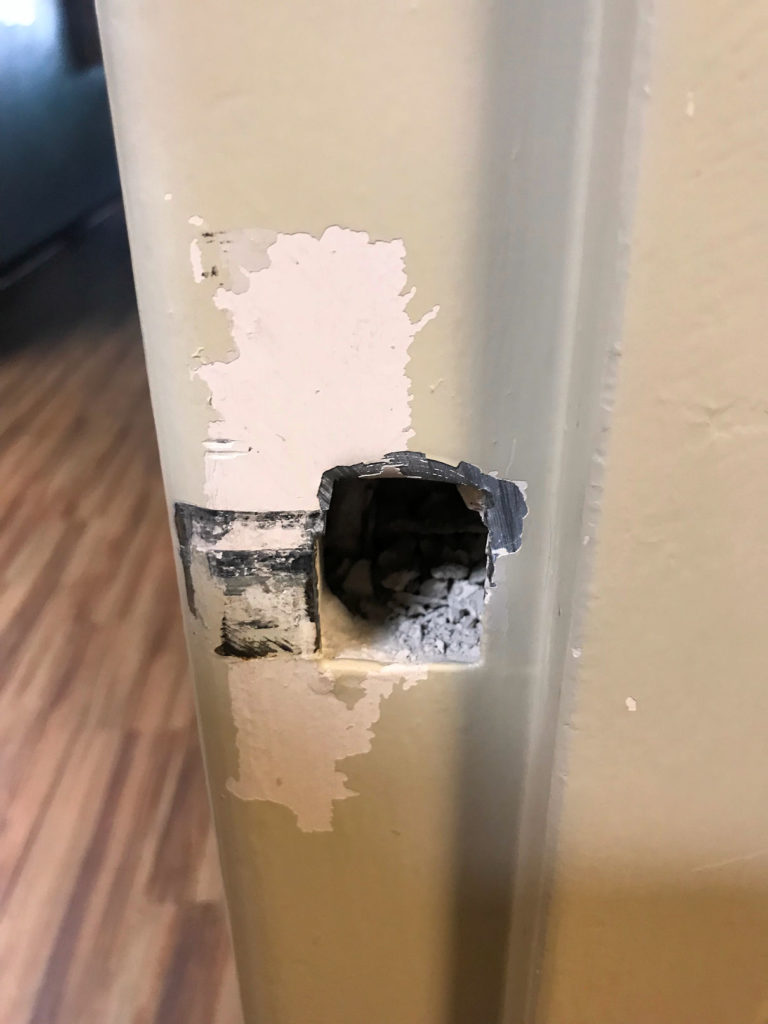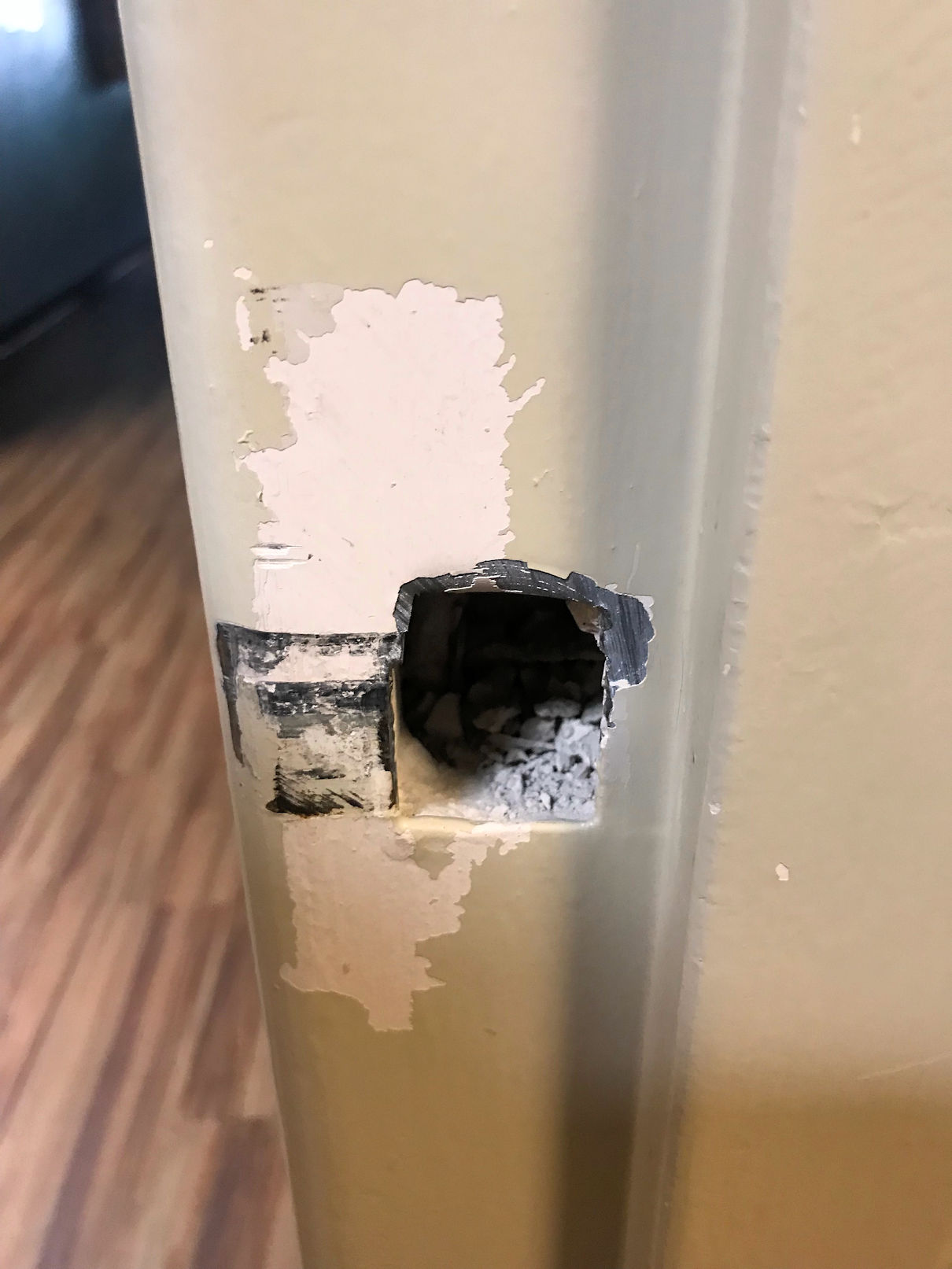 Someone asked me about this the other day, and I’m wondering if any of you have a better answer than, “No, because I said so.” The question is this:
Someone asked me about this the other day, and I’m wondering if any of you have a better answer than, “No, because I said so.” The question is this:
On a fire door assembly, is it acceptable to drill/cut a hole in the frame for the latchbolt, and not install the strike?
This isn’t specifically addressed in the model codes or referenced standards…I guess it’s just assumed that the hardware has to be installed with all of its components – including the strike. I asked one of our compliance engineers, who happened to be headed to one of the test labs for a fire test. He said that the test standards always reference a strike when evaluating pass/fail and locations of the latchbolt engagement.
In order for a hole with no strike to be allowed on a fire door assembly, it would have to be covered by the listings of the fire door and frame, and the application would need to be tested to ensure the proper performance without the strike. I don’t know of any manufacturers that have tested products without the strike, so in my opinion (and our compliance engineer’s, and unofficially – the engineers’ at the test lab) it is not acceptable to have a fire door assembly with just a hole for the latch and no strike.
Anyone know different? Or have evidence to show more definitively why this isn’t allowed?
WWYD?
Photo by Hal Kelton of DoorData Solutions
You need to login or register to bookmark/favorite this content.






I don’t see any reason why it wouldn’t work but I also understand that the regulations are based on testing. It is a lot less expensive for the end user to properly prep for a strike than for them to pay for testing the application. When you put it to them that way, they will probably understand too.
One of the reasons that you can’t file down a strike is because the non plated metal can cause the latch to wear and the two raw surfaces can get jammed, or be difficult to open, in an emergency. At least according to my AHJ. I would say that the raw metal on the frame would also wear the latch and potentially cause the same issue. This is more of an egress issue than a fire issue but still a requirement for the door to be acceptable.
That’s interesting, Fred. I had not actually heard that before.
– Lori
That would be impossible to achieve due to the amount of different trades installing door frames incorrectly ( drywallers, brick masons and Carpenters ) sometimes filling is the only solution
I would say it wouldn’t be allowed as there would not be a strike pocket welded to the inside of the frame. This could possibly cause smoke and flame to enter the wall cavity.
Lori. As always thanks for all you do. I have seen this in the field. It was always my thought that since this frame does not have a Wrought Box behind what would be the strike and it is not originally prepped for a strike that this would fail for a few reasons. First to me at least it is missing a strike (missing parts). Second it has a field modification possibly not allowed by the frame manufacturer . Third it has no Wrought Box for proper latch throw and protection. It most likely was not nor could be tested as such because then you would have to exactly replicate that hole in the field if it were allowed. Also smoke gases could escape through the frame during a fire. I have also seen hole drilled like this in head jambs for flush bolts with no strike prep. Just a thought. Thank you
Several manufacturers make strikes from brass material. So they certainly have no fire rating.
I would have to say that I agree with the friction being an issue but mostly that all components of the listed assembly need to be in place and functioning properly to meet inspection and code. I think we need a comment from the photographer who took the picture since he would have the completion understanding of the assembly and or other conditions of it’s use and location. What if had been cutout to use a thumb strike. I think it would require that the completed assembly has been tested with any and all components or modifications to be legal.
Actually the way the cut-out is, it looks like they are totally trying to put a deadbolt in the hole, thus the door
NO NO
NFPA 80 2016 edition 6.5.2. the catchall code. Manufacturers’ Instructions. ALL components shall be installed in accordance with the manufacturers’ installation instructions and shall be adjusted to function as described in the listing. Enough said in my opinion.
Having installed hardware on doors for over a quarter of a century, I don’t know of any lock manufacturer that does not supply a strike with the lockset and have specific installation instructions that includes the installation of the provided strike. I also would raise the question as to why the strike prep was not performed under labelled service as required by 4.1.3.1. Keep in mind now that I don’t know of any lock manufacturer that does not supply a strike with the lockset so the prep for the strike would fall under the umbrella of locks and or latches depending on if it is flush bolts that we are talking about. As an inspector, if the frame did not come prepped for a strike plate then maybe they are installing a lock that is not supposed to be installed on that door assembly, ie. a mortise/cylindrical lock instead of the fire exit device that the label on the door calls for. And if your a good enough inspector and have a maintenance/door tech escorting you on the inspection, you can probably get the tech to tell on him/herself or one of their coworkers just by commenting on how well or bad the hole looks. I know this to be true from first hand experience on both sides of that coin. Ok, now enough said.
Thanks for weighing in on this, Paul.
– Lori
I suspect it would be unacceptable to both the fire marshal (inspector) & UL. When fire testing is done for certification of the locks, the installation must be complete and all of the components of the certified product must be included as shown in the mfg. site certification directory. When UL inspects the manufacturing site the inspector looks to verify that the same components assembled in shipped product are the same as those reflected on the drawings of the lock that UL has on file regarding the product configuration of the unit certified. In addition, the strike limits the amount of lost motion when the door is swinging away from the frame. Excessive lost motion of the closed door would cause issues for test validation. The following are just a few of pass/fail requirements that must be met.
– Doors must be secure in the frame
– No door movement of meeting edges exceeding door thickness during endurance (face to face or face to frame).
– No door movement of meeting edges exceeding 1.5 times door thickness during hose stream (face to face or face to frame)
– No transmission of flame from one side of door that could ignite carpeting etc. on opposite side of door.
– Door must be secure after the hose stream test. Warping of the door during the fire test or loading of the door from hose stream could cause the door to swing open failing the test.
Finally, I suspect the UL listed frame would not be considered complete without the strike.
Thanks Vince!
– Lori
Major Mfg. Co. offers a variety of mounting brackets for proper field installation of various locks and strikes in hollow metal doors and frames not originally so prepared. Of course, any such modification of a listed fire door would need to be made by a certified installer.
Pete Schifferli
Thanks Pete!
– Lori
I would agree with Paul and call it a field modification that’s not allowed per NFPA80.
There are people that can fix that before it is even an issue.
That is just a show of laziness.
Lori,
Had to go back a few years to find the answer to this question.
UL-63 fire Door Frames, dated 11/19/1978, Section 6.25 to 6.34 deals with strike reinforcement requirements in pressed steel frames.
Drilled and tapped 12 Ga. tabs are required to be welded to the back of the strike jamb with a minimum of three spot welds. There
is no mention of a dust cover requirement, however I believe most manufacturer’s would incorporate the cover into the reinforcement
for grouted masonry frame applications. For a number of years, KD drywall jambs did not have grout boxes.
I believe if you were to research NFPA-252 you would find that UL 63 is a referenced publication and it requires welded in strike tabs.
Tom
Thanks Tom!
– Lori
NFPA 80 would not allow it, section 4.1.3.2.1 only allows up a 1″ round hole, this is a square hole. But I have a question, how is a fire rated door frame supplied without a strike since the door must be self latching?
Rim exit devices have surfaces mounted strikes , mortise type come with asa prep.
My first question would be to ask “why does the frame have a fire rated label without a strike prep?”
Since latching is a requirement for fire rated openings, the frame was clearly mislabeled to begin with.
Once you get past this point, the next point would be that that field modifications are not allowed on fire frames/doors unless approved by the listing agency and the manufacture.
Next, a strike box is not installed. In a non-grouted frame, this would allow flames, and smoke to penetrate through the backside of the frame. In a grouted frame, grout chips and dust could build up in the cavity drilled for the latch bolt and cause the latchbolt to not engage.
In other words, NO is the correct answer.
First to answer Lori’s question “NO” it is not acceptable to modify the frame in this way.I think the bigger question in this case “dose this particular door need to be fire rated?
It looks like it could have been a door originally designed with no latching hardware “push pull maybe”? if the opening needs to be fire rated and is a means of egress it should have had a
rim exit device installed.
I encountered one like this in Syracuse last year. That opening, in a hotel, originally had a fire-rated rim exit device, and when the hotel remodeled, they removed the rim exit device and replaced it with a lever passage set. They caulked the holes where the exit device strike used to be, and routed a hole for the latchbolt in the frame.
I see this quite often and reached out to a manufacture of the specific lock set that was on the doors in question. Their technician replied and said a strike was needed to meet the fire rating.
This looks like a strike prep for a surface mount electric strike was either removed or not yet installed. As I cannot see the hardware on the door . In any case something needs to be corrected here .